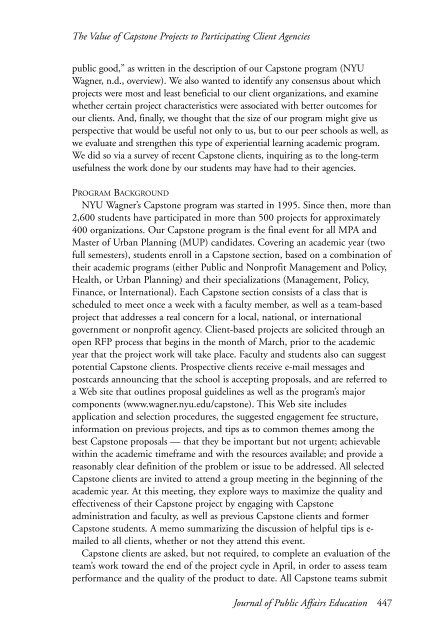JOURNAL OF PUBLIC AFFAIRS EDUCATION - National ...
JOURNAL OF PUBLIC AFFAIRS EDUCATION - National ...
JOURNAL OF PUBLIC AFFAIRS EDUCATION - National ...
You also want an ePaper? Increase the reach of your titles
YUMPU automatically turns print PDFs into web optimized ePapers that Google loves.
The Value of Capstone Projects to Participating Client Agencies<br />
public good,” as written in the description of our Capstone program (NYU<br />
Wagner, n.d., overview). We also wanted to identify any consensus about which<br />
projects were most and least beneficial to our client organizations, and examine<br />
whether certain project characteristics were associated with better outcomes for<br />
our clients. And, finally, we thought that the size of our program might give us<br />
perspective that would be useful not only to us, but to our peer schools as well, as<br />
we evaluate and strengthen this type of experiential learning academic program.<br />
We did so via a survey of recent Capstone clients, inquiring as to the long-term<br />
usefulness the work done by our students may have had to their agencies.<br />
PROGRAM BACKGROUND<br />
NYU Wagner’s Capstone program was started in 1995. Since then, more than<br />
2,600 students have participated in more than 500 projects for approximately<br />
400 organizations. Our Capstone program is the final event for all MPA and<br />
Master of Urban Planning (MUP) candidates. Covering an academic year (two<br />
full semesters), students enroll in a Capstone section, based on a combination of<br />
their academic programs (either Public and Nonprofit Management and Policy,<br />
Health, or Urban Planning) and their specializations (Management, Policy,<br />
Finance, or International). Each Capstone section consists of a class that is<br />
scheduled to meet once a week with a faculty member, as well as a team-based<br />
project that addresses a real concern for a local, national, or international<br />
government or nonprofit agency. Client-based projects are solicited through an<br />
open RFP process that begins in the month of March, prior to the academic<br />
year that the project work will take place. Faculty and students also can suggest<br />
potential Capstone clients. Prospective clients receive e-mail messages and<br />
postcards announcing that the school is accepting proposals, and are referred to<br />
a Web site that outlines proposal guidelines as well as the program’s major<br />
components (www.wagner.nyu.edu/capstone). This Web site includes<br />
application and selection procedures, the suggested engagement fee structure,<br />
information on previous projects, and tips as to common themes among the<br />
best Capstone proposals — that they be important but not urgent; achievable<br />
within the academic timeframe and with the resources available; and provide a<br />
reasonably clear definition of the problem or issue to be addressed. All selected<br />
Capstone clients are invited to attend a group meeting in the beginning of the<br />
academic year. At this meeting, they explore ways to maximize the quality and<br />
effectiveness of their Capstone project by engaging with Capstone<br />
administration and faculty, as well as previous Capstone clients and former<br />
Capstone students. A memo summarizing the discussion of helpful tips is emailed<br />
to all clients, whether or not they attend this event.<br />
Capstone clients are asked, but not required, to complete an evaluation of the<br />
team’s work toward the end of the project cycle in April, in order to assess team<br />
performance and the quality of the product to date. All Capstone teams submit<br />
Journal of Public Affairs Education 447

















